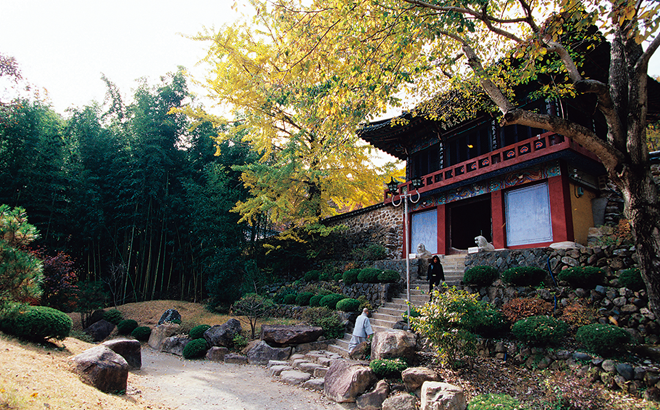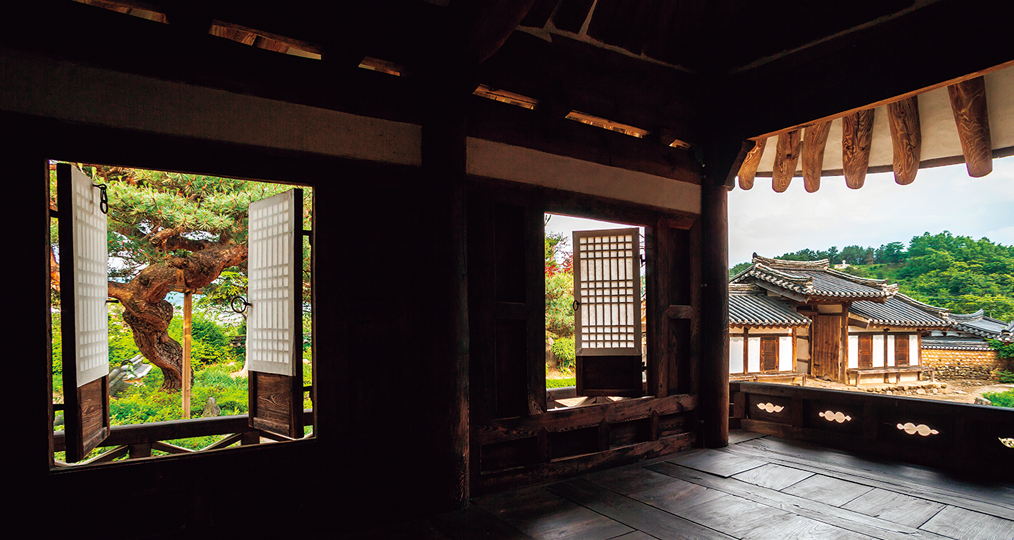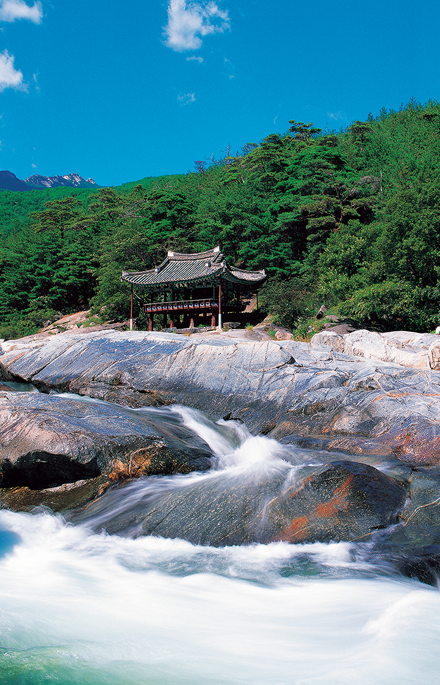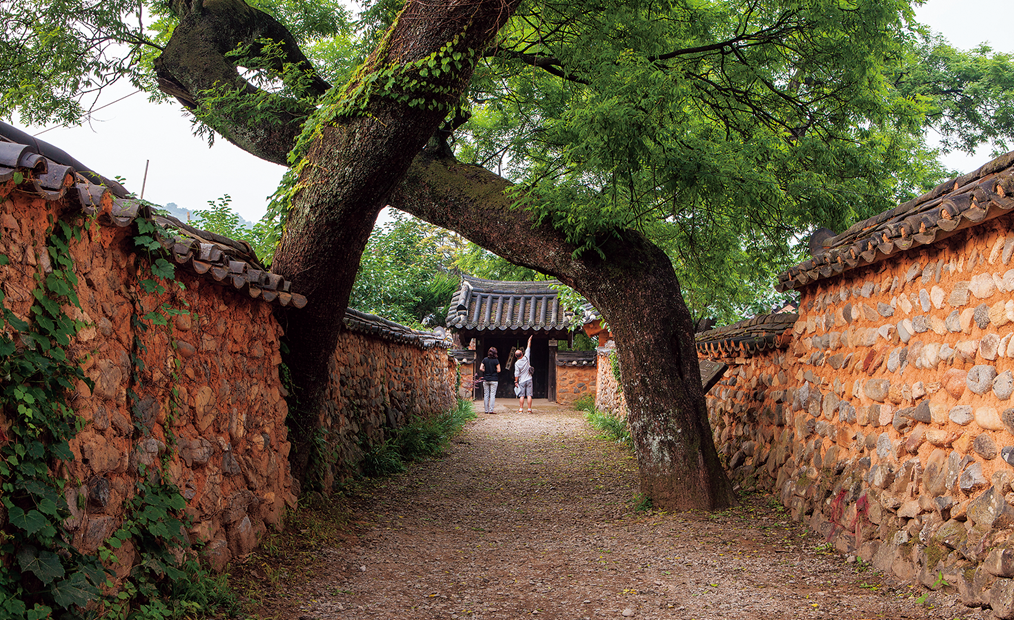Hamyang and Sancheong, both in South Gyeongsang Province, are two of several counties in the three provinces spanned by the alpine region known as Mt. Jiri, which is a massive cluster of ridges and peaks that dominate Korea’s far southern landscape. Connected by scenic roadways and extensive networks of hiking trails, this area is a snug and entrancing travel destination where the mountains beckon and the fields invite you to linger awhile. As you walk around, the gentle air of spring seems to carry the faint fragrance of scholars’ ink of the past.
Layers of ridges of Mt. Jiri viewed from Nogodan, one of the mountain’s many peaks. Mt. Jiri, which straddles North Jeolla, South Jeolla and South Gyeongsang provinces, was designated Korea’s first national park in 1967, in recognition of its outstanding natural scenery and wealth of historical, cultural and folk heritage sites. This photograph, “Azaleas on Nogodan Peak,” is by Kim Jae-young.
There are two smells I have always liked: That of my mother’s milk and the mountains in early spring. To be honest, I have no real memory of the smell of my mother’s milk. More than 60 years have passed since those days, so the smell is only a vague notion to me. I suppose it comes from one of the most beautiful sights I have seen in my life, that of a mother with a baby at her breast. I’ve trekked the Himalayas on six occasions, but even more moving than the mystical panorama of the snowy mountains was the sight of women in the alpine villages feeding their babies at their breasts. Despite the gaze of an outsider, the women showed no embarrassment. When I met their eyes, they smiled cheerfully and greeted me: “Namaste!” It’s because they look upon outsiders with the eyes of a mother. My own mother is no longer here with me. She doesn’t even appear in my dreams.
A Trail of Memories
All through the trip to Unbong from Namwon, crossing over Jeongnyeongchi Hill of Mt. Jiri, I drank
in the smell of the mountains. I love the early spring aroma of the mountains coming in through the car
window. It’s a bit like the smell of books on the shelves of an old library, or the lingering scent from the
first draft of a poem written through the night. The smell of the mountains in spring — permeating the
old wooden bench on the train platform, the whistle of the long-distance train, and the backs of travelers
standing on the platform slurping instant noodles — hangs in the air serenely, an evanescent blessing.
The mountain never says, read my dreams. It simply stands silently in the same place and waits
for the next page in the scenery, which will soon appear. The smell not detected even on the body of a
traveler who has been all over the world is found in the mountains in early spring. The car runs quietly
through that fragrance.

Daewonsa, one of the numerous old Buddhist temples on Mt. Jiri, sits on the eastern slope of the mountain in Sancheong County, South Gyeongsang Province. Passing through the pavilion gate, one enters the main courtyard of the temple. It is one of the country's major temples exclusively inhabited by female monks.
A long time ago, I once went trekking on Mt. Jiri, passing through the valley of Baengmudong (“One
Hundred Shamans’ Village”). I was not alone. In life, there are fateful moments that are hard to pass off
simply as a matter of luck. That was one of such moments. Only the gods know why that person came
trekking to Mt. Jiri with me.
On our way up the mountain we stopped for lunch at a small village. Our host brought out some kimchi
that had a curious odor. It was totally new to me. I thought it might be jasmine or maybe lavender.
The host said it was prickly ash. I tasted that herb for the first time and found its totally new smell quite
appealing. After watching me eat with relish, our host offered us some advice: “The weather may have
turned warm, but it’s still cold at the top of the mountain. You should take this bundle of straw with you.”
The terraced rice fields of Macheon village in Hamyang have been selected by CNN as one of the top 50 places in Korea to visit.
Stored in the house were bundles of straw left over from the rice threshing in autumn. I took his advice. Clumsily I loaded a bundle of straw onto my backpack (weighing more than 10 kilos I’m sure) and continued to climb up the mountain. When we reached the camping ground, I laid the straw on the ground, as we had been advised. When we lay down, it was soft beneath us. Lying on the straw with two blankets on top, the lamp lit, inside the tent it was warm and comfortable. When we woke up in the morning the tent was covered in a white layer of frost. That night inside the tent, we kissed for the first time, and when we came down from the mountain we got married and eventually had two children.
Bridge for Everlasting Love
The car traces over my memories of Mt. Jiri toward Hamyang. This name is the same as that of the first capital of China (Xianyang in Chinese) when it was unified by Qin Shi Huang, or King Zheng of Qin, the first emperor of China. The meaning of the name is indicated in the Chinese characters: “For all people to live under the warm sunshine.” My footsteps then head for Sangnim.
Sangnim, or the Upper Forest, was planted 1,150 years ago by the scholar Choe Chi-won (857–?) during the reign of Queen Jinseong of Silla. It is the oldest man-made forest in Korea. Choe went to study in Tang China at the age of 11, passed the imperial civil service examinations at the age of 17, and returned to Silla at the age of 28. Requesting a regional posting, he served as governor of Hamyang County. It is 2 64 Koreana Spring 2016 said that Choe, after seeing the devastation wrought by frequent floods, planted the forest to reinforce the banks of the river running through the middle of the county and thus prevent the damage caused by flooding.
The smell of the mountains in spring — permeating the old wooden bench on the train platform, the whistle of the long-distance train, and the backs of travelers standing on the platform slurping instant noodles — hangs in the air serenely, an evanescent blessing.
At the entrance to the forest is a tree with entwined trunks, which is the subject of an enchanting legend. Trees with entwined trunks are called yeonlimok (“tree with joined bodies”) and those with entwined branches are called yeonliji (“joined branches”). In the olden days, the presence of such trees was considered to be an auspicious sign for the nation. The tree at the entrance of this forest consists of two species, a zelkova tree and a hornbeam tree, joined together at their trunks. Around the time Choe Chi-won created the forest, there was a young man living on the other side of the river who crossed over every night to see the woman he loved. When Choe heard about this, he placed stepping stones in the water. Though the stepping stones have disappeared with the passage of time, the local residents built a bridge over the river that was named Cheonnyeongyo (“Bridge of a Thousand Years”). They call this tree “the tree of love,” and according to local legend, any couple who passes under the tree together will be blessed with everlasting love. Covering an area of over 200,000 square meters, this man-made forest contains some 20,000 broadleaf trees of 120 species, and has been designated Natural Monument No. 154.

The elevated veranda at the old house of Jeong Yeo-chang in Hamyang, South Gyeongsang Province. The front gate of the house can be seen over the classical railings.

Nongwoljeong pavilion in Hamyang. The name of the pavilion, meaning
"flirting with the moon," was inspired by the beautiful sight of the moon
reflected on the water over the rocks.
Pride in the Upright Scholarly Spirit
From the Joseon period, the people of Hamyang liked to say, “Andong on the left, Hamyang on the right.” This reflects the Hamyang people’s pride in their home region as the cradle of the “seonbi spirit,” or the spirit of the virtuous scholars. Hamyang to this day bears traces of the lives of scholars whose names are widely known among Koreans, including Choe Chi-won (pen name Goun), Kim Jong-jik (Jeompiljae, 1431–1492), Jeong Yeo-chang (Ildu, 1450–1504), and Park Ji-won (Yeonam,1737–1805).
I make my way to the village of Gaepyeong, a neighborhood of traditional-style houses, or hanok. Crossing a small bridge and entering the village, I immediately notice the village rice mill standing at the foot of a hill covered with a grove of exquisite old pines. In old country villages, the state of the rice mill spoke for the state of the people’s lives. The more briskly the rice mill was operated the more comfortable the livelihoods of the village households would have been.
Next, I go to see the old house of Jeong Yeo-chang. Jeong was a leading figure in the rustic sarim faction that in the mid-Joseon Dynasty was engaged in a power struggle against the political elites entrenched in the royal court. Many regionally-based scholars were exiled or executed; the dead were even dug up from their graves and mutilated during the literati purges of 1498 and 1504, carried out by Prince Yeonsan, the most despotic king in Korean history.
A cluster of 12 separate structures, the house was built by Jeong’s descendants after he was posthumously reinstated when King Jungjong succeeded to the throne as the result of a coup. A large plaque hanging at the entrance to the sarangchae, the men’s quarters of the house, bears an inscription: Baekse cheongpung. It’s an exhortation — Jeong’s ardent desire for his descendants to live as clean and honest officials generation after generation.
Anyone who is fond of drinking must try the home-brewed solsongju, rice wine infused with pine buds, the scent of which permeates the house. With a history and tradition of five hundred years, it was brewed by Jeong’s descendants to be offered to their ancestors in memorial rites, a gesture of utmost respect.
I wanted to taste this wine made with the new buds of young pines gathered in spring and to experience the same poetic inspiration of the ancient scholars. But unfortunately, there was no one at the visitor center to help me sample it.
From the top of the hill at the end of the path, named Ildu Trail after Jeong’s pen name, which means
“sole moth,” the whole village is spread out below. The old houses with tiled roofs seen through the
branches of the pine trees look handsome and orderly. Lucky for me, I catch the sight of smoke rising
from the houses along the brook where dinner is being cooked. In the past, when travelers were searching
for a place to stay the night they would look for smoke coming from the chimneys. If the flowers
were in bloom in the yards and the smoke from cooking could be seen around dinner time, the travelers
would think, Yes, this is where I’ll have to stay tonight. I may not have been lucky enough to taste the
“pine bud wine,” but as I fully savored the scent of the old pines and the smoke rising as rice was being
cooked, you could say I had enjoyed songyeonju, or “pine smoke wine.”
I turn the car toward Daewon Temple in Sancheong. In the vicinity of Gyeongho River, flowing at the
foot of Mt. Jiri, are a handful of mountain villages with such lovely names as Sicheon (“Arrow Stream”),
Chansaem (“Cold Spring”), and Deokgyo (“Bridge of Virtue”). The glowing lights of the villages blanketed
in darkness create a graceful scene. The lights of a few houses up on top of the mountain look
like fireflies. Among the numerous Buddhist temples nestled in Mt. Jiri, Daewonsa is well-known for
the sound of the stream running through the deepest of valleys. The sound of the stream follows me the
entire time I am driving up miles of the mountain road, all the while taking in the invigorating scents of
the mountain. In the midst of it all, the stars are shining brightly and the sound of a metal drum can be
heard signaling the start of evening service at the temple.
Walking through the temple grounds in the dark, I reach the main hall, Daeungjeon, when a nun
greets me with her hands devoutly pressed together. I press my hands together and say, “It’s late, seunim.
But I wanted to take a look around the temple at night.” Without a word, she leaves with quick steps.
I wanted to stay the night at the temple and listen to the sound of the water and smell the mountain all
through the night, but alas this dream was not to be. Instead, I stay at a house in a small village below
the temple where I dine on rice along with deliciously seasoned greens. The lights of the riverside villages
resemble flowers.
Glowing Lights of Mountain Villages
In 1989, I traveled to the western regions of China with the novelist Lee Myeong-han, who grew up in
a family of traditional medicine practitioners. We visited Dunhuang, Turpan and Urumqi, and Lee told
me about a fantastic medicinal herb that grew in China’s western regions, called dongchung hacho, or
“caterpillar fungus.” I was doubtful when he told me about this mystical herb that was a plant in the
summer and a bug in the winter, but at a medicine shop in Liuyuan I saw it for myself. I can still remember
the way the novelist cradled it in his hands as if it were something very precious. He told me that the
most fundamental aspect of traditional Korean medicine was using the sense of smell for treatment.
The pleasant scents of mountain herbs were said to drive all negative things out of the body, which I
believed was a whole different story from the dubious-looking caterpillar fungus.
In Sancheong, there is a theme village dedicated to the Dongui bogam (“Principles and Practice of
Eastern Medicine”), which was built to commemorate the 400th anniversary of the ancient Korean medical
text written by Heo Jun. The Oriental Medicine Museum there introduces the medicinal herbs that
grow around the foothills of Mt. Jiri. A compendium of traditional Asian medicine, Dongui bogam has
been published in China and Japan, and is also listed on the UNESCO Memory of the World Register.
Namsa Yedam Village is an archetypal scholars’ village of the Joseon period. The name means “a
village with beautiful old walls.” At the entrance to the village, a signpost marks the road that Admiral
Yi Sun-sin traveled on over five hundred years ago, on his way to the battlefield as a plain soldier after
being stripped of his title and command.
The road is lined with elegant ancient walls carefully built of
stone and red earth. At the entrance to an alley leading to one of the old houses are two “scholar trees”
with their branches joined overhead, as if greeting all visitors. More than 300 years old, these locust
trees are so called because it is said the green energy that emanates from them enables scholars to
clear their minds. In geomantic terms, the village is in the configuration of two dragons breathing fire.
The trees were planted to contain the flames.
The walls enclosing the houses, standing higher than the average person, may be a little bit puzzling
to some travelers. It would seem more natural for the front yard to look out at the mountains and fields
in the distance. A scholar with profound learning and lofty virtue would not have built the walls so high, I
tell myself, but the faint smell of spring earth coming from the old walls is pleasant.

Entwined trees stand at the entrance of Sangnim forest in Hamyang. According to legend, couples who pass under the trees together will have their love blessed.